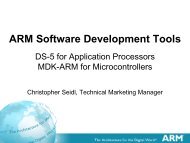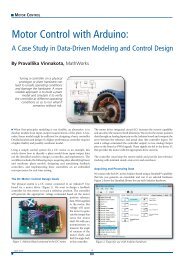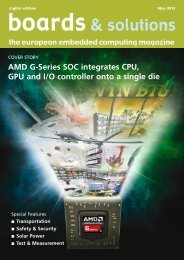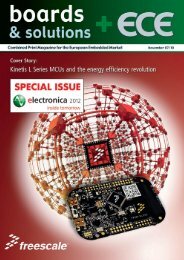LIGHTINGFigure 1. The True Color sensor MTCSiCFenables colour measurement based on theCIE1931/DIN5033 standard.mind, alternative approaches are required thatare either applied within the displays via backlightor light engine control, or allow remotemonitoring of display segments. Similar approachesare found in alternative applications,for example the lighting industry, where mixedLED light sources that require to maintainspecific colour temperature use feedback control-loopsolutions.The colour measurement of such applicationsis performed by compact JENCOLOR TrueColour sensors. Supplemented with appropriatesignal electronics, they enable new opportunitiesfor device manufacturers and inline colourmeasurement of light sources and displays.The semiconductor-based sensors with XYZinterference filters are fast, cost-efficient andenable long-term stable colour detection andabsolute colour measurement based on theCIE1931/DIN5033 standard. These sensors arecapable of measuring colour differences withinthe colour space that are beyond the capabilityof the human eye. MAZeT offers these kindsof True Color Sensor ICs in various packagesand embedded solution options including calibrationlibraries. (Sensor IC, evaluation boardsfor various applications).The True Colour sensor IC MTCS is a miniaturizedcolour sensor for colour measurementsbased on the tristimulus procedure. The differencebetween usual colour sensors with absorptionfilters and RGB detection is that theMTCS can perform colour measurements witha spectral sensitivity based on the accuracyand performance of but better than the humaneye. The standard values for the description ofthe colour areas X, Y and Z are a result of theemitted radiation and the spectral tristimulusfunction based on the colorimetric principleof True Color sensors. A nearly spectrally identicalsimulation of the CIE 1931 standard observeris required for a precise color measurementof emitted sources based on human eyeperception. The quality of the viable colourmeasurement depends on the quality of thesefactors. Every variation of the standard observervalues increases the total error of the colourmeasurement system. Depending on the task,the measurement system requires certain accuracy,as measurement error varies from thenominal value, even after a previously performedcalibration. This deviation is definedas measurement error delta (for example ∅Efor the deviation within the Lab-graph or∅u’v’ for the colour area error within theLu’v’-graph) and is used for colour measurementapplications. Certain factors like themeasurement procedure, absolute and repeataccuracy of the sensor, lighting, calibrationand disturbing sources of the system environmentare the determinants of the requestedaccuracy levels.Figure 2. The JENCOLOR sensors consist ofspectral filters that are based on human eyeperception - that is standardized in colorimetrictasks based on CIE 1931.Currently the MTCS colour sensors are theonly miniaturized sensors based on the scaledtristimulus function. The sensor signals XYZcan directly be evaluated as colour areas withinthe colour graph. After calibration and underusual measurement conditions is possible toachieve values better than the perception limitof the human eye („Better than the humaneye“; ∅E
LIGHTINGThe True Color sensors are available as an ICor board solution developed by MAZeT. Theyare commonly used in measurement devicesor systems of various manufacturers, for example,within the calibration system Mii 2mobile colour analyzer developed by Premosysenabling to manage the colour intensity andcontrast of displays with pin-point accuracy..The system is applicable to different displaytypes, regardless of CCFL, LED or RGB backlight,for both narrow- or wide-range. The deviceprovides excellent repeatability, is easy touse and allows a very fast calibration of displays. Atlantik presents Greenvity s HomePlugGreen PHY for LED lightingAtlantik Elektronik introduces the latest memberof Greenvity Hybrii family, the new Hybrii-Mini GV7013. This chip is compatible to thePLC HomePlug Green PHY for Smart Gridapplications and is ideal for intelligent LEDlighting systems over long distances withinthe commercial, public and private sector. TheGV7013 enables a robust and reliable twowaycommunication of remote-controlledstreet lights up to digital signage applications.In residential and commercial buildings theHybrii-Mini PLC also enables larger transmissiondistances through multiple walls andceilings.News ID 16878 ams: intelligent LED driver for mobilephone camerasams introduced a new intelligent LED driverfor mobile phone cameras that maximizesthe brightness of the flash without causingthe phone’s battery to fall below its minimumoperating voltage. The AS3649 LED driveruses an innovative “diagnostic pulse” – a burstof controlled high current lasting a few milliseconds– immediately before every flashoperation. During this pulse the devicemeasures the momentary voltage across theThe achievable accuracy lies in a region thatwas previously only manageable by very expensivemeasurement systems. The system isavailable in different versions with USB orRS232 interfaces. It is possible to perform upto eight base calibrations in addition to thirtyindividual user calibrations to meet the demandsof customer-specific displays. Likewise,flicker measurements can be performed. Theintegrated temperature sensor compensatesthe temperature shift during the measurement.The integrated design ensures the long-termstability of the measurement values. TheProduct Newsterminals of the phone’s battery. On the basisof this measurement, it reports a value for thehighest flash drive current the battery cansustain, up to a maximum of 2.5A, withoutdropping below its minimum voltage andtriggering the phone to reset itself during themain flash.News ID 16965 Electronic Assembly: 5.7“ color displayincludes touchscreen capabilityThe EA eDIPTFT57-A intelligent display fromElectronic Assembly is, for a variety of reasons,the ideal candidate for implementing an interactivecontrol in mechanical engineering orindustrial electronics applications. The highcontrastscreen, for example, which measures5.7“ in the diagonal and has LED backgroundillumination, offers a crisp, colorful resolutionof 640 x 480 pixels.News ID 16979 FTDI: easy-to-use graphic controller forwide-ranging display applicationsAddressing the need for ever more advancedforms of human-machine interaction, FTDIhas announced the release of the FT800, theinitial offering in its Embedded Video Engine(EVE) family. Targeted at cost-effective, intelligentQVGA and WQVGA TFT display panels,measurement device is calibrated individually,and can always be recertified, so that the systemcan be used as reliable test equipmentfor several years.Similar solutions for screen measurementsexist from other companies. The Brontes Colorimeterfrom Admesy was developed for displayapplications where colour rendering isextremely important and long-term stabilitymust be guaranteed without re-calibration. Inaddition to the high accuracy, an extremelyhigh measuring speed is a selling point. the FT800’s object oriented approach rendersimages in a line by line fashion with 1/16th ofa pixel resolution, eliminating the expense oftraditional frame buffer memory. Supporting4-wire resistive touch sensing with built-inintelligent touch detection and an embeddedaudio processor allowing midi-like soundscombined with pulse code modulation foraudio playback, the controller’s functionalitysets new industry benchmarks.News ID 16915 ARM: adoption of ARM big.LITTLEtechnology acceleratedARM unveiled that its big.LITTLE processingtechnology has been adopted by many of theworld’s leading mobile chip manufacturers.Samsung and Renesas Mobile have alreadyannounced their plans, and subsequent implementationswill be revealed during 2013 byfive more companies including CSR, FujitsuSemiconductor and <strong>Media</strong>Tek. ARM big.LIT-TLE technology saves up to 70 percent ofprocessor energy consumption in commonmobile workload tasks, essential as the performanceof the smartphone has jumped by60x since 2000 and 12x since 2008, causing amassive increase in both content generationand consumption.News ID 1693115 April 2013
















